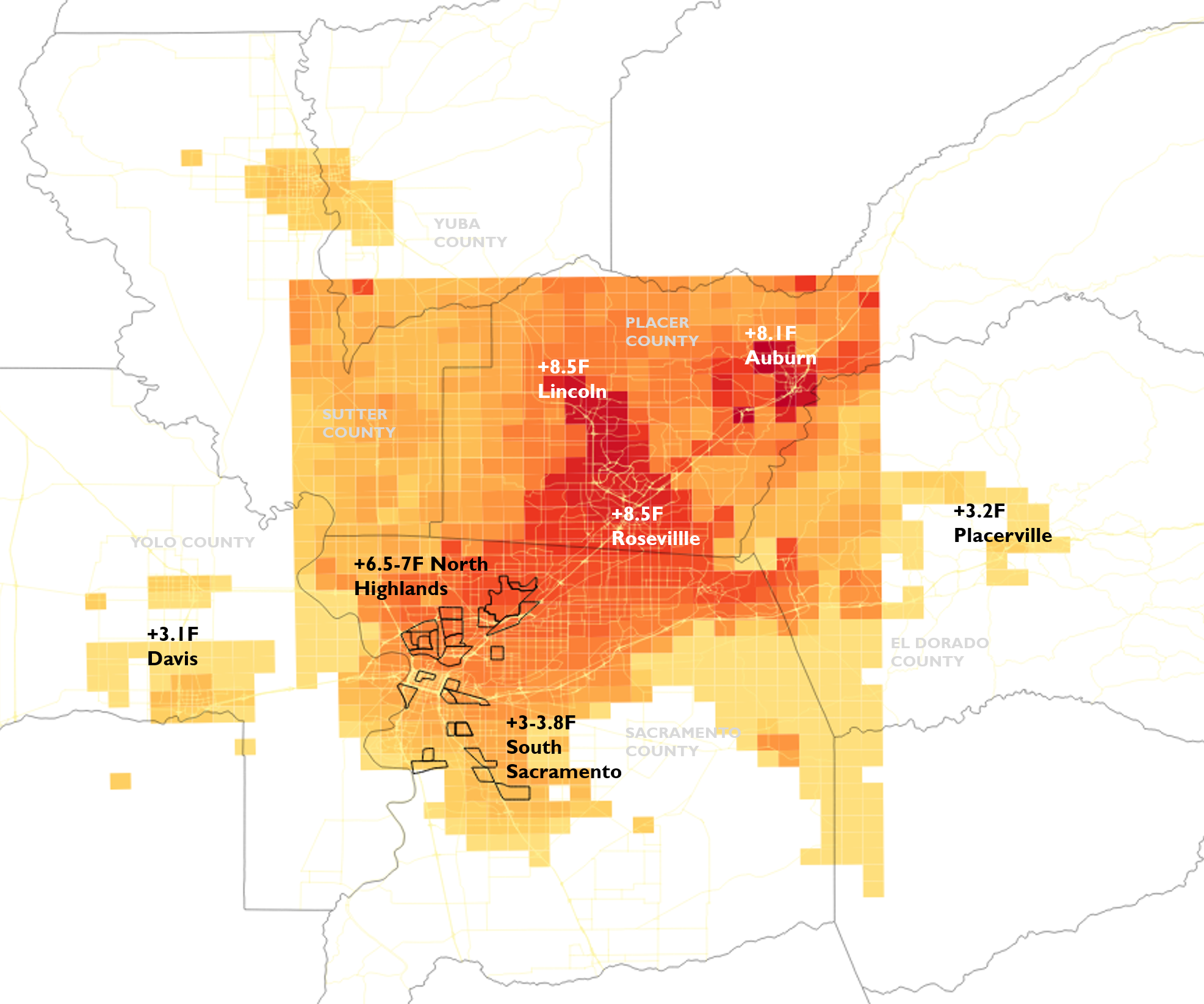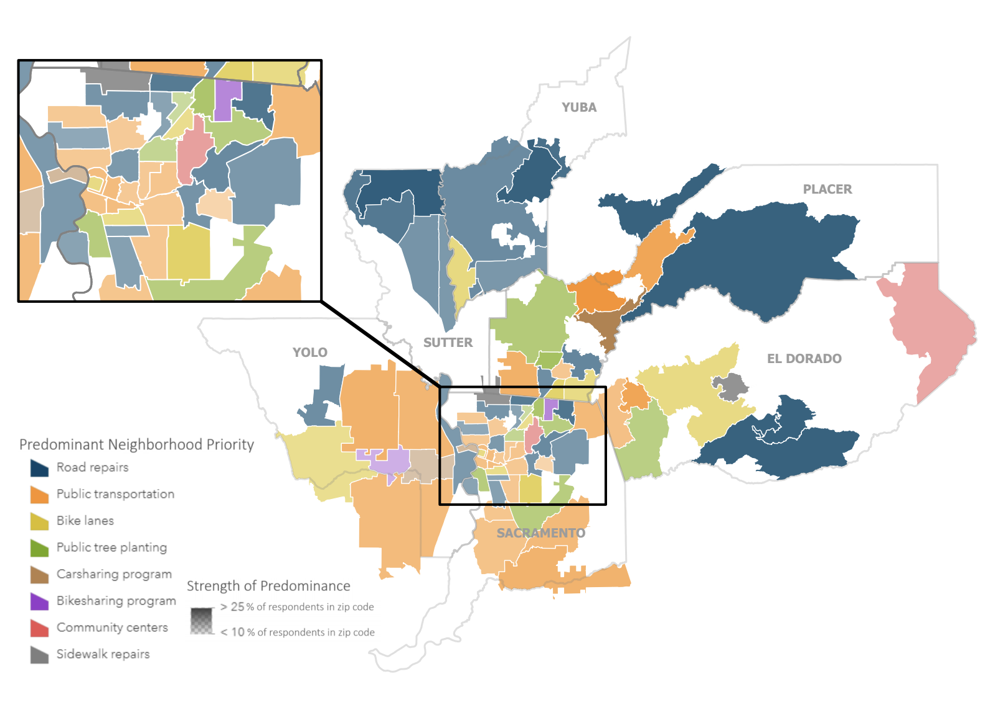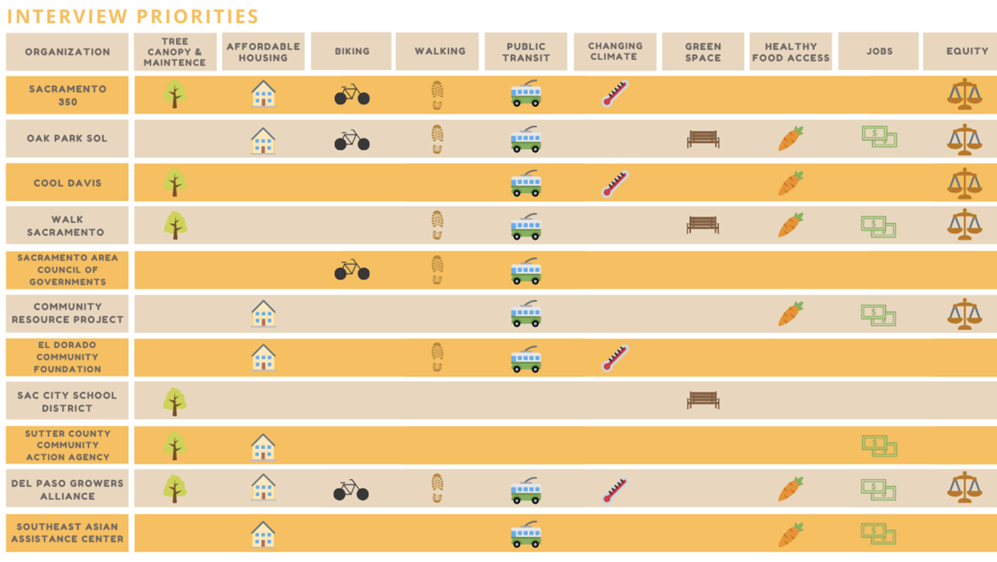Capital Region Transportation Sector: Urban Heat Island Mitigation Project
SB1 Adaptation Planning Grant: Final Case Study
Summary
Extreme heat is increasingly threatening the health, safety, infrastructure, and the economy of California’s Capital Region. To address this challenge, between May 2018 and February 2020, the Capital Region Urban Heat Island Mitigation Project evaluated the most effective strategies to reduce the urban heat island (UHI) effect – the additional heat in urban areas generated by the built environment.
The project developed a model of the UHI effect in the Sacramento Region to analyze the effectiveness of transportation-oriented heat mitigation measures. These findings were translated into transportation resilience planning recommendations for local governments.
The project demonstrates an integrated adaptation/mitigation approach, as many urban cooling strategies also reduce GHG emissions and energy use. It also undertakes focused heat island analysis for disadvantaged communities. The project supports the State of California's goals for climate resilience planning and the California Transportation Plan 2040’s goals for a vibrant multi-modal transportation system.
This project supports California’s climate mitigation and adaptation goals as well as its vision of a resilient, multi-modal transportation system (CA Transportation Plan 2040). Planning for UHI reduction can achieve regional cooling that benefits public health, water and energy savings, air quality, stormwater absorption, groundwater recharge, and improved public spaces. As heat increases, street and transit design improvements – such as trees, water fountains, and shaded bus shelters – will be critical for pedestrians, cyclists, and transit users.
Community engagement, particularly with under-resourced neighborhoods, is a core part of the project. Project staff will seek input from communities on their transportation needs, concerns, and priorities, and staff will incorporate feedback into plans and recommendations.
Lead Agency and Partnerships
The Sacramento Metropolitan Air Quality Management District (SMAQMD) is the lead agency working with sub-applicant the Local Government Commission (LGC). Additional support came from the Sacramento Municipal Utility District (SMUD), which helped to develop the concept and provided support, as well as the Capital Region Climate Readiness Collaborative (a cross-sectoral, multi-jurisdictional collaborative of agencies and stakeholders in the Sacramento Region) and Placer County Air Pollution Control District (PCAPCD). Participating agencies include El Dorado County, Yolo County, City of Davis, City of Sacramento, and Sacramento County.
Drivers
The Sacramento Region already bears a disproportionate heat-health burden, with the number of heat-related deaths and hospital visits exceeding the state average. The Sacramento region experiences heat-related deaths and hospital visits in excess of the state average. CalEPA’s statewide Urban Heat Island Index (2015) provided an initial – but partial – analysis of the regional UHI effect for Sacramento; but a more comprehensive, regional approach is required to develop successful heat mitigation strategies. The CRCRC, of which SMAQMD is a member, proposed to build upon this study for the entire region.
Engagement Process
Populations vulnerable to extreme heat for physiological reasons include the elderly, children, and people with pre-existing health conditions. Others are vulnerable due to socioeconomic factors; this includes outdoor workers, workers in unconditioned spaces, and those without vehicle access, experiencing homelessness, living in substandard housing, experiencing social or linguistic isolation, or facing financial challenges. Finally, there are systemic barriers that prevent individuals from comfortably or safely accessing health care, cooling centers, or other government services tasked with addressing extreme heat.
The project team gathered input from vulnerable communities on transportation and heat using a survey informed by listening sessions with local community and environmental groups. Instead of hosting standalone events dedicated to heat, the team attended community events planned by independent cultural and community organizations to decrease barriers to attendance. At the events, the project team engaged people to take the survey (translated into 10 languages) and shared information about extreme heat. In February 2020, the project team visited community meetings to share information on project findings, and resources and strategies for keeping cool. The Communities Priorities Report summarizes outreach activities, community interests and concerns, their heat exposure, transportation needs, and preferred transportation sector improvements.

The project team engaged with stakeholders through a technical advisory committee of local and regional agencies and organizations. The committee provided feedback and suggestions on project scope, mitigation measures, focus areas for in-depth modeling, community outreach, draft reports, and other project tasks. After project completion, the project team will continue to engage with stakeholders to encourage implementation of heat mitigation strategies.
Climate Impact Area
Already a critical challenge, extreme heat is projected to worsen as climate change intensifies. The transportation sector, with its miles of highways, roads, and other paved surfaces, is one of the largest contributors to the UHI effect, and is also vulnerable to extreme heat.
This project supports resilience by identifying priority areas in the region for heat reduction and recommends multiple strategies to reduce the UHI effect. A combination of tree canopy and high-albedo roofs and pavements was the most effective cooling scenario for the region. Other measures, such as zero-emissions vehicle deployment, infill development (instead of new growth), solar photovoltaic shading, and cool walls, also contributed to localized cooling. The report also found that cooling potential is doubled with regional coordination and action. Many recommended cooling strategies also reduce GHG emissions, such as by reducing cooling loads or encouraging tree planting.
The project goal is to support jurisdictions to adopt urban cooling measures and community-supported recommendations in their policies and programs. The project team plans to meet with jurisdictions to share findings and track the number of programs and projects that implement these measures as an indicator of success.
Funding Source
This project was funded by Caltrans’s SB1 Adaptation Planning Grant, which awarded SMAQMD $487,775 in December 2017. Local match came from the Local Government Commission, Altostratus, Inc., SMUD, and the CRCRC.
Research and Data
The project contributes to urban heat tools, resources, and data, and draws from land use, land cover, and weather data to generate the models; the research methodology is discussed in the technical analysis report. All data and results are publicly available in the form of shapefiles (GIS data), spreadsheets, and a collection of interactive maps on the project website (see below), which also hosts the project reports and other resources for local governments as well as individuals.
Challenges
The grant-mandated timeline was a challenge for this extensive modeling project. The project team would recommend creating a plan for ongoing outreach and information dissemination after the grant timeline. The project team also found it difficult to contact and engage rural and suburban communities. With more time, more in-depth research into community groups and other organizations could have created more enriching outreach opportunities. The project’s modeling consultant also suggested rebranding ‘urban heat island’ to ‘heat pollution’ to make it more clear to the layperson that rural and suburban areas also suffer from the UHI effect.
Outcomes
Data and research-related outcomes include UHI data, analysis of heat mitigation measures, and a technical report on UHI modeling. Other deliverables include a Community Priorities Report, a mitigation plan synthesizing results into strategies for the transportation sector, and an electric vehicle and charging infrastructure heat adaptation report. Taken together, these resources aim to reduce regional UHI through improvements in the transportation sector and street design, prioritizing vulnerable communities. All information will be consolidated for a cool communities toolkit, which equips individuals to teach their communities about urban heat.
Next steps will include engaging jurisdictions to encourage implementation of heat mitigation measures in transportation projects and plans to gradually reduce UHI. The project aims to elevate heat as a critical challenge, spurring programs, projects, and ordinances to build heat resilience.
Replicability
This project’s resources and recommendations can be adopted by other jurisdictions. While the size of the UHI effect may differ, the mitigation strategies and general heat-related information remain applicable for most of California. Those looking to develop localized UHI modeling projects can look to this project for recommendations regarding outreach and modeling methodology. Overall, the reports and resources make the case that designing our built environment to cool neighborhoods is essential as the globe sees hotter, longer extreme heat events.
Additional Resources
Project website: https://urbanheat-smaqmd.hub.arcgis.com
Further Information
Please contact Shelley Jiang (sjiang@airquality.org, 916.874.4885), climate change program coordinator, at SMAQMD.

